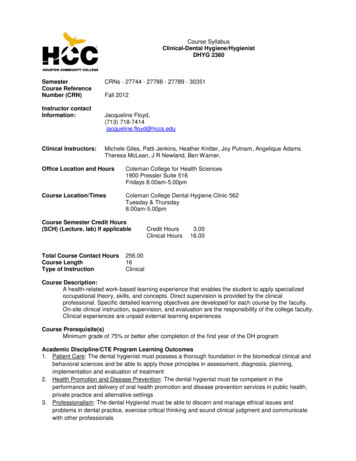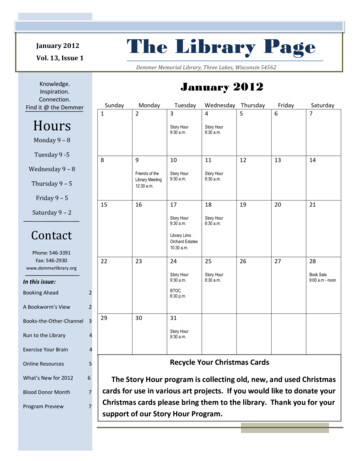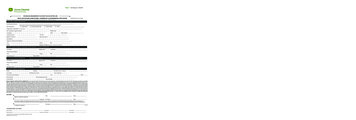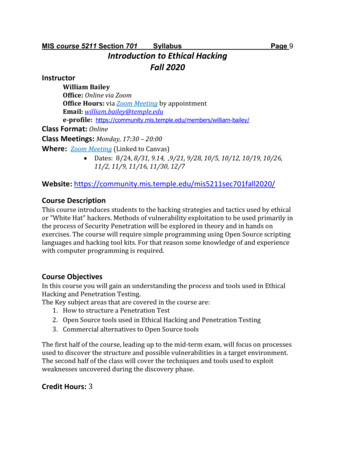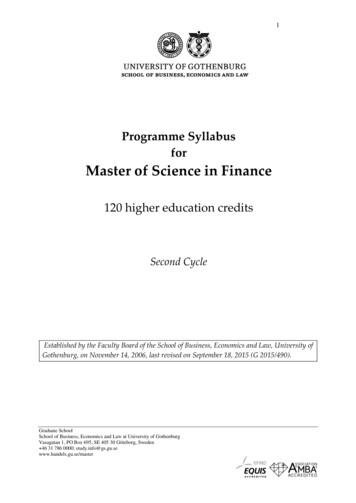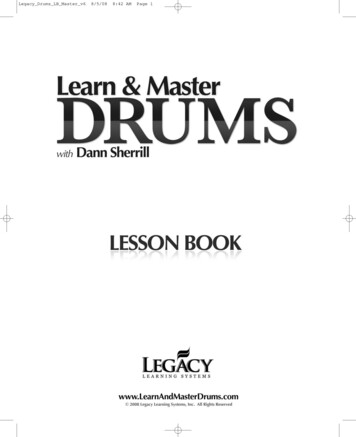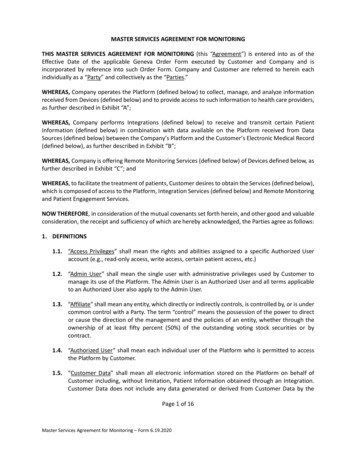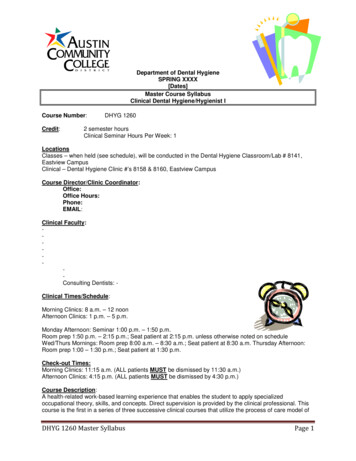
Transcription
Department of Dental HygieneSPRING XXXX[Dates]Master Course SyllabusClinical Dental Hygiene/Hygienist ICourse Number:Credit:DHYG 12602 semester hoursClinical Seminar Hours Per Week: 1LocationsClasses – when held (see schedule), will be conducted in the Dental Hygiene Classroom/Lab # 8141,Eastview CampusClinical – Dental Hygiene Clinic #’s 8158 & 8160, Eastview CampusCourse Director/Clinic Coordinator:Office:Office Hours:Phone:EMAIL:Clinical Faculty:Consulting Dentists: Clinical Times/Schedule:Morning Clinics: 8 a.m. – 12 noonAfternoon Clinics: 1 p.m. – 5 p.m.Monday Afternoon: Seminar 1:00 p.m. – 1:50 p.m.Room prep 1:50 p.m. – 2:15 p.m.; Seat patient at 2:15 p.m. unless otherwise noted on scheduleWed/Thurs Mornings: Room prep 8:00 a.m. – 8:30 a.m.; Seat patient at 8:30 a.m. Thursday Afternoon:Room prep 1:00 – 1:30 p.m.; Seat patient at 1:30 p.m.Check-out Times:Morning Clinics: 11:15 a.m. (ALL patients MUST be dismissed by 11:30 a.m.)Afternoon Clinics: 4:15 p.m. (ALL patients MUST be dismissed by 4:30 p.m.)Course Description:A health-related work-based learning experience that enables the student to apply specializedoccupational theory, skills, and concepts. Direct supervision is provided by the clinical professional. Thiscourse is the first in a series of three successive clinical courses that utilize the process of care model ofDHYG 1260 Master SyllabusPage 1
assessment, dental hygiene diagnosis, planning, implementation, and evaluation. Critical thinking skills,time management, and self assessment are emphasized for the practical application of dental hygienetheory. In this competency-based clinical course students provide comprehensive dental hygiene care forpatients with routine needs with an emphasis on re-care cases. Clinical practice is an unpaid learningexperience.Prerequisites:Successful completion of:DHYG 1227 – Preventive Dental Hygiene Care;DHYG 1301 – Orofacial Anatomy, Histology, & Embryology;DHYG 1331 – Preclinical Dental Hygiene;DHYG 1304 – Dental RadiologyCourse Rationale/Philosophy:The clinical program is designed to allow you to focus on providing comprehensive dental hygiene carefor each patient. Further the clinical environment is designed to emphasize managing the patient from aholistic view. You will be responsible for the care of a patient pool for the purpose of providing you withthe opportunities to gain experience in the various treatment procedures which comprise dental hygienepractice.Your patient pool will approximate the patient population that a dental hygienist would encounter in ageneral dental practice. Your patients will include adolescent (age 12 or older), adult and geriatricindividuals, both healthy and medically compromised, and patients limited to the followingclassifications/descriptions: healthy recall/re-care type patients with minimal amounts of calculusclassified as calculus types 0, 1, or 2 and presenting with gingivitis/periodontitis limited to a generalizedloss of attachment of less than 4mm, thus classified within periodontal categories A or B.No Pediatric (under age 12 without Clinic Coordinator approval), moderate, or advanced type cases,calculus types 3 or 4, or periodontal category C or higher, will be treated in Clinic I. Screened patientswill supplement the pool of patients you are expected to acquire from the local community. Yourexperiences in clinic will emphasize skill acquisition in: 1) assessing each patient's general health status,2) assessing each patient's oral health status, 3) creating a corresponding dental hygiene diagnosis, 4)devising a related dental hygiene treatment plan, 5) educating patients in acquiring adequate plaqueremoval skills and general oral and overall health concepts based on risk assessment findings, and 6)performing dental hygiene treatment. The instructors’ primary role will be to function as a facilitator to aidyou in acquiring these skills.Texas Workforce Education Course Manual End-of Course Outcomes:As outlined in the learning plan, apply the theory, concepts, and skills and involving specialized materials,tools, equipment, procedures, regulations, laws, and interactions within and among political, economic,environmental, social, and legal systems associated with the practices, interpersonal and teamwork skills,and appropriate written and verbal communication skills using the terminology of the occupation and thebusiness/industry.Overall Course Goals:The goals of this course are to provide the student with the opportunity to:1.obtain and document patient assessment information;2.develop individualized dental hygiene diagnoses and corresponding treatment plans;3.and provide comprehensive dental hygiene care to adolescent, adult and geriatricpatients, both healthy and medically compromised, classified as calculus types 0, 1, or 2,and presenting with gingivitis/periodontitis limited to a generalized loss of attachment ofless than 4mm, categories A or B.DHYG 1260 Master SyllabusPage 2
Course Objectives:Upon completion of Clinic I, the student will be able to:1.2.3.4.5.6.7.8.9.10.11.Obtain, record, and assess a thorough and accurate health and dental history on a clinical patientto include vital signs.Perform extra and intraoral inspections and accurately record a description of hard and softtissues findings using correct, professional, and focused terminology.Assess the periodontium typical of the recall/re-care patient with minimal attachment loss todetermine gingival health and disease by visual inspection, probing, and deposit assessment,recording findings accurately.Obtain and record an accurate plaque record/clinical index and relate the findings to a patient'shome care regimen and dental history.Analyze patient assessment data to develop a dental hygiene diagnosis and create anindividualized treatment plan for dental hygiene care, including clinical services, nutritional, andpreventive counseling.Assess and restore instrument sharpness for the purposes of maintaining instrument conditionwhile preserving original design characteristics.Maintain mastery in the demonstration of basic instrumentation skills (preclinical).Complete an oral prophylaxis on calculus type 0, 1, and/or 2 cases with minimal attachment loss,including calculus removal and selective polishing.Administer professionally applied topical fluoride treatments.Demonstrate professionalism in behavior, manner, and judgment in the clinic and during clinicalrotations.Establish and maintain an exposure control regimen maintaining the chain of asepsis for eachpatient appointment and for all procedures.The standards for the objectives may be one or any combination of the following:As presented, demonstrated, discussed in the lab experience;given in handouts;stated in the course texts/resource media;presented in prerequisite courses.This course is designed to support the student’s development in the knowledge, skills, and valuesrequired for graduation from the Program and dental hygiene licensure eligibility. Specifically this coursepromotes the development of the dental hygienist as defined by the following Educational Standards ofthe American Dental Association Commission on Dental Accreditation (ADA CODA), the AustinCompetency Analysis Profile (ACAP), and the Department of Dental Hygiene competency statements.ADA CODA Educational Standard 2-9General education content must include oral and written communications, psychology, and sociology.ADA CODA Educational Standard 2-10Biomedical science content must include content in anatomy, physiology, chemistry, biochemistry,microbiology, immunology, general pathology and/or pathophysiology, nutrition and pharmacology.ADA CODA Educational Standard 2-11Dental sciences content must include tooth morphology, head, neck and oral anatomy, oral embryologyand histology, oral pathology, radiography, periodontology, pain management, and dental materials.ADA CODA Educational Standard 2-12Dental hygiene science content must include oral health education and preventive counseling, healthpromotion, patient management, clinical dental hygiene, provision of services for and management ofpatients with special needs, community dental/oral health, medical and dental emergencies, legal andethical aspects of dental hygiene practice, infection and hazard control management, and the provision oforal health care services to patients with bloodborne infectious diseases.DHYG 1260 Master SyllabusPage 3
ADA CODA Educational Standard 2-13The basic clinical education aspect of the curriculum must include a formal course sequence in scientificprinciples of dental hygiene practice, which extends throughout the curriculum and is coordinated andintegrated with clinical experience in providing dental hygiene services.ADA CODA Educational Standard 2-14The number of hours of clinical practice scheduled must ensure that students attain clinical competenceand develop appropriate judgment. Clinical practice must be distributed throughout the curriculum.ADA CODA Educational Standard 2-15The dental hygiene program must have established mechanisms to ensure a sufficient number of patientexperiences that afford all students the opportunity to achieve stated competencies.ADA CODA Educational Standard 2-17Graduates must be competent in providing the dental hygiene process of care which includes:a)b)c)d)e)f)Comprehensive collection of patient data to identify the physical and oral health status;Analysis of assessment findings and use of critical thinking in order to address the patient’sdental hygiene treatment needs;Establishment of a dental hygiene care plan that reflects the realistic goals and treatmentstrategies to facilitate optimal oral health;Provision of patient-centered treatment and evidence-based care in a manner minimizing risk andoptimizing oral health;Measurement of the extent to which goals identified in the dental hygiene care plan are achieved;Complete and accurate recording of all documentation relevant to patient care.ADA CODA Educational Standard 2-19Graduates must be competent in interpersonal and communication skills to effectively interact withdiverse population groups.ADA CODA Educational Standard 2-21Graduates must be competent in providing appropriate life support measures for medical emergenciesthat may be encountered in dental hygiene practice.ADA CODA Educational Standard 2-22Graduates must be competent in applying ethical, legal and regulatory concepts to the provision and/orsupport of oral health care services.ADA CODA Educational Standard 2-23Graduates must be competent in the application of self-assessment skills to prepare them for life-longlearning.ADA CODA Educational Standard 2-25Graduates must be competent in problem solving strategies related to comprehensive patient care andmanagement of patients.ADA CODA Educational Standard 5-3The program must establish, enforce, and instruct students in preclinical/ clinical/laboratory protocols andmechanisms to ensure the management of emergencies. These protocols must be provided to allstudents, faculty and appropriate staff. Faculty, staff and students must be prepared to assist with themanagement of emergencies.DHYG 1260 Master SyllabusPage 4
PROGRAM STUDENT LEARNING OUTCOMESUpon completion of the Associate of Applied Science degree in Dental Hygiene the graduate will:1.2.3.4.5.6.7.8.9.10.11.12.13.14.Communicate a commitment to ethical, legal, and professional behaviors including embracingresearch and life-long learning.Support and assist the functions of the dental team and the business of dentistry.Implement an organized system of exposure control for the purposes of protecting themselvesand others from infectious and unsafe agents.Implement an organized review of the physical surroundings to ensure a safe environment forthemselves and others.Collect, assess, document, and communicate dental patients’ medical, dental, familial, and socialhistories to include predisposing and etiologic risk factors, and initiating referrals.Provide the information necessary for a dental patient/guardian to make an informed decision andobtain an informed consent for dental hygiene procedures.Collect, assess, document and communicate dental patients’ existing orofacial conditions toinclude extraoral and intraoral cancer screenings, obtaining dental radiographs and photographs,and existing intraoral hard and soft tissue conditions.Assess, document, prepare and communicate dental hygiene diagnoses, and develop dentalhygiene and preventative care plans that are holistic and individualized.Implement, document, evaluate, and modify the dental hygiene and preventive care plans.Initiate and assume responsibility for health promotion and disease prevention.Recognize and manage medical emergencies in the patient care environment.Promote the values of oral and general health to the public.Assess, plan, implement, evaluate, and value community oral health services.Serve diverse patient populations without discrimination.SCANS COMPETENCIESAdditionally this course is designed to support the student’s development of the following skills as defineby the Secretary of Labor’s Commission on Achieving Necessary Skills (SCANS)FOUNDATIONAL SKILLS(a)Basic Skills:Reading: locate, understand, and interpret written informationWriting: communicate thoughts, ideas, information, and messages in writingArithmetic and Mathematical Operations: perform basic computations and approach practicalproblems by choosing appropriately from a variety of mathematical techniques.Listening: receive, attend to, interpret, and respond to verbal messages and other cues.Speaking: organize ideas and communicate orally.(b)Thinking Skills:Creative Thinking: generate new ideas.Decision Making: specify goals and constraints, generate alternatives, consider risks, andevaluate and choose the best alternative.Problem Solving: recognize problems and devise and implement plan of action.Visualize: organize and process symbols, pictures, graphs, objects, and other information.Knowing How to Learn: use efficient learning techniques to acquire and apply new knowledgeand skills.Reasoning: discover a rule or principle underlying the relationship between two or more objectsand apply it when solving a problem.(c)Personal Qualities:Responsibility: exert a high level of effort and persevere toward goal attainment.Self-Esteem: believe in one's own self-worth and maintain a positive view of oneself.Sociability: demonstrate understanding, friendliness, adaptability, empathy, and politeness ingroup settings.DHYG 1260 Master SyllabusPage 5
Self-Management: assess oneself accurately, set personal goals, monitor progress, and exhibitself control.Integrity and Honesty: choose ethical courses of action.WORPLACE COMPETENCIES(a)Resources: A worker must identify, organize, plan, and allocate resources effectively.Time: select goal-relevant activities, rank them, allocate time, and prepare and follow schedules.Material and Facilities: Acquire, store, allocate, and use materials or space efficiently.Human Resources: Assess skills and distribute work accordingly, evaluate performance andprovide feedback.(b)Interpersonal Skills: A worker must work with others effectively.Participate as Member of a Team: contributes to group effort.Teach Others New Skills.Serve Clients/Customers: work to justify position, persuade and convince others, responsiblychallenge existing procedures and policies.Exercise Leadership: communicate ideas to justify position, persuade and convince others,responsibly challenge existing procedures and policies.Negotiates: work toward agreements involving exchange of resources, resolve divergentinterests.Work with Diversity: work well with men and women from diverse backgrounds.(c)Information: A worker must be able to acquire and use information.Acquire and Evaluate Information.Organize and Maintain Information.Interpret and Communicate Information.Use Computers to Process Information.(d)Systems: A worker must understand complex interrelationships.Understand Systems: know how social, organizational, and technological systems work andoperate effectively with them.(e)Technology: A worker must be able to work with a variety of technologies.Select Technology: choose procedures, tools or equipment including computers and relatedtechnologiesApply Technologies to Task: understand overall intent and proper procedures for setup andoperation of equipment.Maintain and Troubleshoot Equipment: Prevent, identify, or solve problems with equipment,including computers and other technologiesRequired Texts:ndDaniel & Harst, Mosby’s Dental Hygiene, Concepts, Cases, and Competencies, 2 Edition, St. Louis:Mosby, 2008. (or most current edition)Nield-Gehig, Jill S., Fundamentals of Periodontal Instrumentation, 6th Edition, Baltimore: LippincottWilliams & Wilkins, 2008.(or most current edition)Wilkins, Esther, Clinical Practice of the Dental Hygienist, 10th Edition, Philadelphia: Lippincott Williams &Wilkins, 2008.(or most current edition)Current Edition ACC Department of Dental Hygiene Clinic ManualRecommended Texts:Dorland’s Pocket Medical Dictionary, Philadelphia, W.B. Saunders Company, mostrecent edition.DHYG 1260 Master SyllabusPage 6
Method of Course Delivery:A combination of patient care, presentations, laboratory instruction, and focused clinical rotationassignments will be used to meet the goal of this course. Clinical concepts will be supported by the use ofan electronic patient management system, electronic presentations, slides, video tapes, transparencies,student patient-partners, teaching typodonts, and mannequins, demonstrations, discussion, andsmall group activities in the clinical laboratory setting.GENERAL GUIDELINESI.The Clinic ManualThe Department of Dental Hygiene Clinic Manual contains information concerning such items asthe acquisition of dental records, samples of chart and teaching forms and the detailed objectives,criteria, and critical errors for performance for each clinical procedure. Therefore, you will beexpected to become thoroughly familiar with the Manual and evaluate your own performanceaccording to the criteria given.II.Faculty FeedbackIt is important that you seek faculty input regarding your performance so that you may: 1) gain confidencein your performance; 2) identify problem areas and determine methods for correcting deficiencies; and 3)attain competence in the clinical skill areas. All students are considered mature enough to seek facultyassistance and to monitor their own progress. Please meet with your assigned instructors or the ClinicCoordinator as soon as possible if you have any questions or difficulties in this course. The faculty iscommitted to supporting your success; please remember, however, that you are the only person who canmake us aware that you need assistance.III.ProfessionalismAll dental hygiene students are expected to demonstrate professionalism in behavior, manner, andjudgment in the dental hygiene clinic and clinical rotation sites. The area of professionalism includesappearance, asepsis, patient management, peer, faculty and staff interaction, and documentation.Guidelines for professionalism and professional appearance are discussed in the Dental Hygiene StudentHandbook. Professionalism will be evaluated on a continual basis.Students will exhibit professional maturity and an acceptable level of clinical judgment as determined bythe clinical faculty. Unprofessional behavior will be documented in written form by the faculty to the ClinicCoordinator. After the first occurrence, the student will meet with the Clinic Coordinator and be placed onProgram Probation for the remainder of the semester. At the second occurrence, the student will failthe course and be administratively withdrawn from the program.** Students cited for unprofessional behavior will lose 4 points from their final grade in thesemester the behavior occurred. **IV.Skill MaintenanceIn a competency based clinical system, dental hygiene studen
The dental hygiene program must have established mechanisms to ensure a sufficient number of patient experiences that afford all students the opportunity to achieve stated competencies. ADA CODA Educational Standard 2-17 Graduates must be competent in providing the
